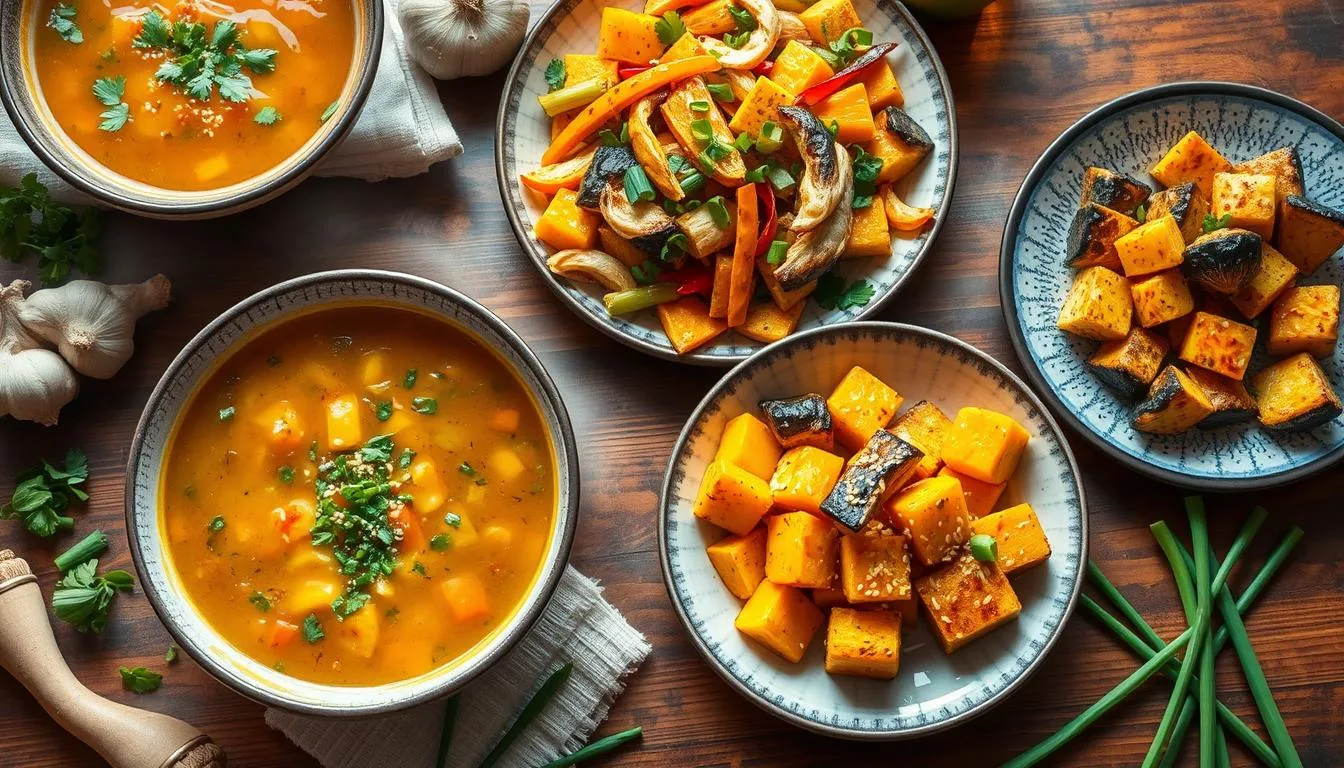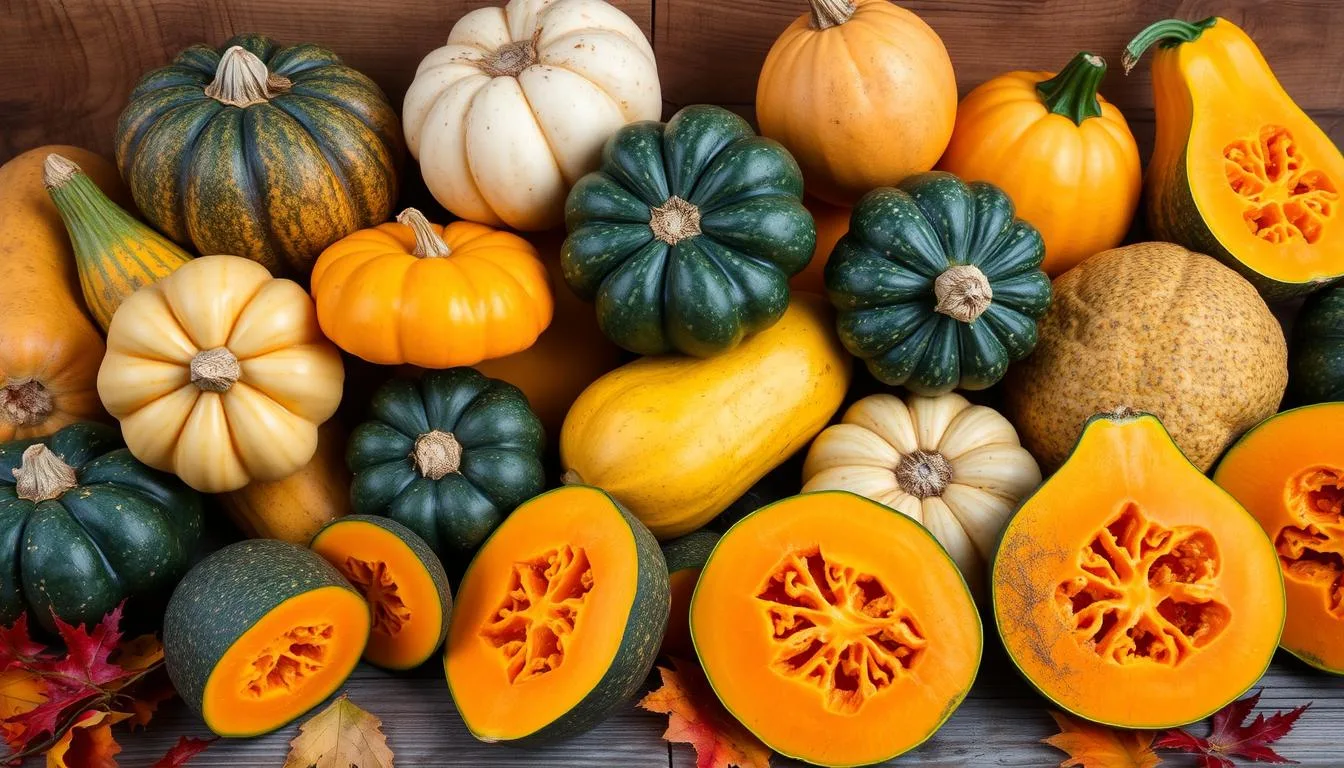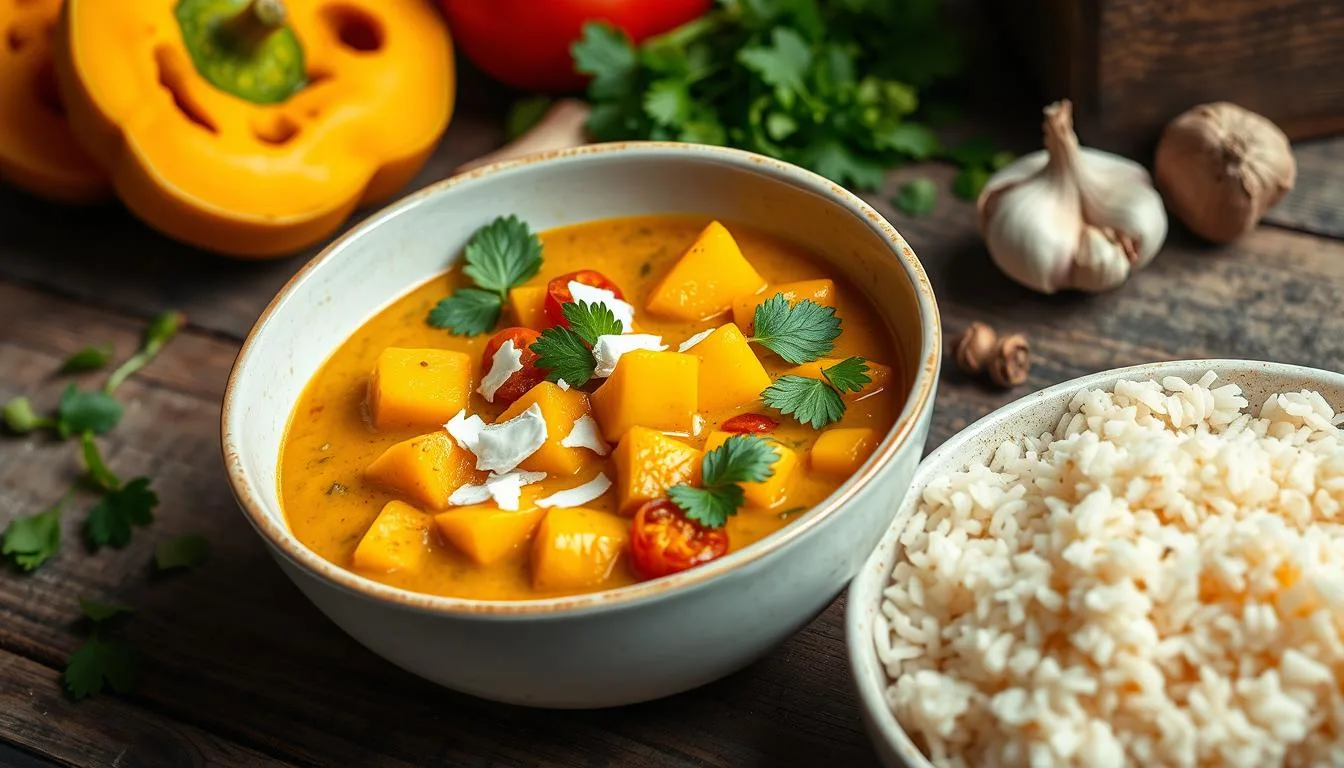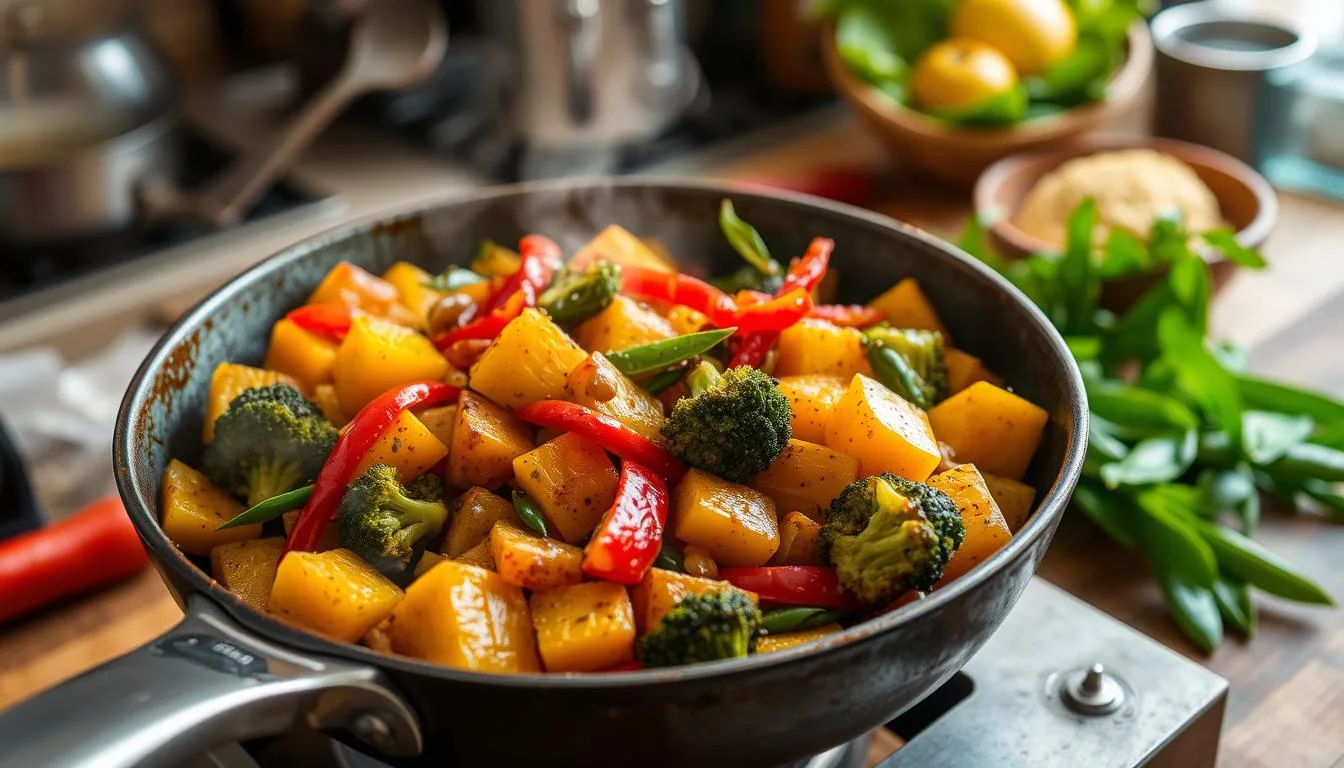
Winter nights are perfect for cozy, comforting meals. A steaming dish of vegan Chinese squash recipes with kabocha is just what you need. This Japanese pumpkin turns simple meals into special treats that feed both your body and soul.
Kabocha squash is a hidden treasure in vegan cooking. It adds a rich, sweet flavor to dishes, similar to butternut squash and sweet potato. It’s a favorite among those who love plant-based cooking.
Exploring these chinese squash recipes kabocha vegan opens up a world of flavors. You can make creamy curries or delicate stir-fries with kabocha. It’s a versatile ingredient that will change how you cook with plants.
Kabocha is not just tasty; it’s also full of nutrients. It’s rich in beta-carotene, making it a health powerhouse. Each recipe brings warmth, nutrition, and the true taste of East Asian cuisine, all plant-based.
Table of Contents
Understanding Kabocha: The Japanese Pumpkin’s Versatility

Kabocha squash, also known as the Japanese pumpkin, is a nutritional powerhouse. It adds excitement to your plant-based Chinese dishes. This squash has a sweet, nutty flavor that makes any recipe special.
Nutritional Benefits of Kabocha Squash
Healthy kabocha recipes reveal a vegetable full of nutrients. Kabocha squash is rich in:
- Beta-carotene
- Vitamins A and C
- Powerful antioxidants
- Essential minerals
“Kabocha is sweet like candy without any added sugar” – Traditional Japanese Food Wisdom
Selecting and Storing Fresh Kabocha
Choosing the right kabocha is key. Look for squash that is:
- 2-3 pounds
- Deep green in color
- Firm and smooth on the surface
For longer freshness, store your squash in a cool, dry place. This way, you’ll always have it ready for your next dish.
Preparing Kabocha for Cooking
Preparing kabocha is easy. You can leave the skin on, which becomes tender. Here’s how to prepare it:
- Wash the squash well
- Microwave for 3-4 minutes to soften
- Cut in half and remove seeds
- Chop into desired sizes
Your kabocha is now ready to shine in delicious vegan recipes. It will delight your taste buds and nourish your body.
| Nutritional Value | Per Serving |
|---|---|
| Calories | 94 |
| Carbohydrates | 13g |
| Protein | 2g |
| Fat | 4g |
Essential Ingredients for Chinese Squash Recipes Kabocha Vegan
Making tasty vegan Chinese dishes with kabocha squash needs the right ingredients. Start your plant-based journey by knowing the key parts that make squash a dish to remember.

- Kabocha Squash: The star of your vegan Chinese dishes, known for its sweet, nutty flavor
- Extra-firm tofu for protein and texture
- Coconut milk or cashew milk for creamy base
- Vegetable broth for depth of flavor
“The magic of vegan Chinese cuisine lies in the harmony of ingredients.”
Aromatics and seasonings are key to making your kabocha recipes shine:
- Fresh ginger and garlic
- Soy sauce or tamari
- Coconut sugar
- Lime juice
- Chinese five-spice powder
| Ingredient | Nutritional Benefit | Flavor Profile |
|---|---|---|
| Kabocha Squash | High in Vitamins A & C | Sweet, Nutty |
| Tofu | Protein-rich | Neutral, Absorbs Flavors |
| Sesame Oil | Healthy Fats | Nutty, Aromatic |
Pro tip: For an oil-free option, use 1/4 cup of vegetable broth when sautéing aromatics. Your vegan Chinese squash recipes will be both delicious and health-conscious.
Traditional Chinese Cooking Methods for Kabocha
Exploring vegan Asian recipes reveals the amazing versatility of kabocha squash. Chinese recipes using this Japanese pumpkin turn a simple ingredient into extraordinary dishes.
Learning to cook kabocha squash requires knowing different techniques. Each method highlights the squash’s unique flavor and texture.
Steaming: Preserving Nutrients and Texture
Steaming kabocha is a gentle way to cook that keeps its nutrients. Cut the squash into chunks and steam for 15-20 minutes until it’s tender. This method:
- Retains maximum nutritional value
- Creates a soft, creamy texture
- Minimizes added fat
- Preserves natural sweetness
Stir-Frying: Quick and Flavorful
Stir-frying makes kabocha into a fast and tasty vegan dish. The secret is quick preparation and high-heat cooking:
- Cut kabocha into thin, even pieces
- Heat wok with minimal oil
- Add aromatics like ginger and garlic
- Cook quickly to maintain crispness
Braising: Deep Flavor Infusion
Braising lets kabocha soak up rich flavors and become tender. Simmer the squash in vegetable broth with herbs and spices, making a comforting vegan main course.
“Cooking is about passion, and kabocha offers endless possibilities for creative vegan cuisine.” – Chef Ming Tsai
Mastering Vegan Kabocha Curry

Explore the world of plant-based Chinese cuisine with a delicious vegan kabocha curry. This dish turns the nutritious squash into a culinary gem. Kabocha squash is packed with about 40 calories per cup, along with vital vitamins and minerals.
“A perfect blend of comfort and nutrition in every spoonful” – Vegan Cooking Enthusiast
To start your healthy kabocha recipe, gather these key ingredients:
- Fresh kabocha squash, cubed
- Thai red curry paste
- Coconut milk
- Mixed vegetables (bell peppers, carrots, green beans)
- Firm tofu
- Fresh herbs for garnish
The secret to this vegan Chinese dish is in how you prepare it. Start by sautéing garlic and ginger in coconut oil. This creates a fragrant base that makes the curry even better. The trick is to find the right spice balance for your taste.
| Ingredient | Nutritional Benefit | Quantity |
|---|---|---|
| Kabocha Squash | High in Vitamin A, Fiber | 1 medium squash |
| Coconut Milk | Dairy-free Cream Alternative | 1 can (400ml) |
| Tofu | Plant-based Protein | 200g |
Add a squeeze of lime juice, a drizzle of tamari, and a bit of coconut sugar to your curry. This mix creates a flavor that honors the rich traditions of plant-based Chinese cuisine. Serve it over steamed rice or noodles for a fulfilling meal.
Quick and Easy Kabocha Stir-Fry Variations
Discover the magic of creating delicious vegan Asian recipes with kabocha squash. These easy squash recipes will transform your Chinese squash recipes into quick, nutritious meals that burst with flavor and authenticity.

Kabocha squash adds a unique sweetness and creamy texture to stir-fries. It’s perfect for fast and flavorful vegan dishes. With minimal preparation, you can make restaurant-quality meals at home.
Garlic Ginger Base
Start your Chinese squash recipes with a robust foundation of minced garlic and fresh ginger. This aromatic combination provides depth and warmth to your vegan kabocha dishes.
- Finely mince 3-4 garlic cloves
- Grate 1-inch fresh ginger root
- Sauté in a hot wok with a small amount of oil
Sauce Combinations
Elevate your easy squash recipes with these dynamic sauce options:
| Sauce Type | Ingredients | Flavor Profile |
|---|---|---|
| Classic Soy | Soy sauce, rice vinegar, sugar | Umami, balanced |
| Spicy Chili | Chili paste, sesame oil, garlic | Bold, fiery |
| Sweet Hoisin | Hoisin sauce, rice wine, ginger | Sweet, complex |
Vegetable Pairings
Complement your kabocha with vibrant vegetables that enhance both nutrition and texture:
- Crisp bell peppers
- Tender bok choy
- Crunchy snap peas
- Sliced mushrooms
Pro tip: Cut kabocha into uniform cubes to ensure even cooking and beautiful presentation.
These vegan Asian recipes are not just meals—they’re a celebration of flavor, health, and culinary creativity. Experiment with different combinations to find your perfect kabocha stir-fry!
Creating Rich Kabocha Soups and Broths
Discover the magic of healthy kabocha recipes. They turn this vibrant Japanese pumpkin into velvety, nourishing soups. Vegan Chinese dishes shine with kabocha, offering a creamy texture and deeply satisfying flavor.
“Kabocha squash brings warmth and nutrition to every spoonful of soup” – Traditional Chinese Cooking Wisdom
Your culinary journey starts with picking the perfect kabocha squash. Look for a vibrant orange flesh and firm texture. This promises a sweet and rich soup base.
Essential Soup Ingredients
- 1 medium kabocha squash, seeded and cubed
- 1 quart vegetable broth
- 1 14-oz can full-fat coconut milk
- Fresh ginger and garlic
- Chinese five-spice powder
To create an authentic soup, roast your kabocha chunks at 425°F for 30 minutes. This intensifies their natural sweetness. It also elevates the soup’s depth and complexity.
| Nutrition Details | Per Serving |
|---|---|
| Calories | 136 |
| Preparation Time | 15 minutes |
| Cooking Time | 30 minutes |
| Storage | Refrigerate up to 5 days |
For an extra layer of flavor, garnish your kabocha soup with roasted cashews, fresh cilantro, or a drizzle of chili oil. These finishing touches turn a simple soup into a gourmet experience.
Kabocha in Traditional Chinese Medicine
Explore the healing power of kabocha squash through Traditional Chinese Medicine (TCM). This vegetable is more than just a tasty ingredient in vegan Chinese recipes. It offers deep wellness benefits rooted in ancient healing practices.
Seasonal Benefits of Kabocha
In TCM, kabocha is seen as a warming food for autumn and winter. Its nutritional profile makes it key in healthy recipes that balance the seasons.
- Supports internal warmth during cold seasons
- Helps regulate body temperature
- Enhances digestive system functionality
Healing Properties
Plant-based Chinese cuisine values kabocha as a healing ingredient. It’s believed to nourish the spleen and stomach, boosting digestive health.
| Health Benefit | TCM Perspective |
|---|---|
| Digestive Support | Strengthens spleen energy |
| Immune Boost | Supports defensive qi |
| Eye Health | Nourishes visual system |
Dietary Recommendations
TCM experts suggest adding kabocha to your diet. It’s especially good for those with weak digestion or looking to balance energy in cooler months.
“Let food be thy medicine and medicine be thy food” – Ancient Chinese Wisdom
By adding kabocha to your vegan Chinese dishes, you’re not just eating well. You’re also embracing centuries of holistic healing traditions.
Storage Tips and Meal Prep Strategies
Learning how to store and prepare meals is key to enjoying healthy kabocha recipes. Your vegan Chinese dishes will stay fresh and tasty with the right methods.
Kabocha Storage Guidelines
Whole kabocha squash does best in cool, dry places. You can keep it at room temperature for up to a month. When picking your squash, choose one that’s firm with no soft spots or wrinkles.
Refrigeration and Preservation
- Cut kabocha should be wrapped tightly and refrigerated
- Stored pieces remain fresh for 5 days
- Cooked dishes can be refrigerated for 3-4 days
- Freeze prepared meals for up to 2 months
Efficient Meal Prep Strategies
Make easy squash recipes by getting ingredients ready ahead of time. Roast kabocha in big batches on weekends. This makes your vegan Chinese dishes quick and easy during the week.
| Preparation Method | Storage Duration |
|---|---|
| Raw pre-cut kabocha | 5 days refrigerated |
| Roasted kabocha | 4 days refrigerated |
| Frozen prepared dishes | 2 months |
“Preparation is the secret to delicious and convenient meals.” – Culinary Expert
Use these tips to turn your healthy kabocha recipes into quick, nutritious meals. They’ll fit perfectly into your busy schedule.
Conclusion
Exploring chinese squash recipes kabocha vegan opens a world of tasty plant-based dishes. Kabocha squash is a nutritional powerhouse. It’s full of beta-carotene, fiber, and antioxidants.
These nutrients make simple vegan Asian recipes vibrant and healthy. Discovering kabocha’s versatility lets you dive into plant-based Chinese cuisine with confidence. You can roast, steam, or blend it to create dishes that are both nutritious and flavorful.
The mix of traditional Chinese spices and fresh veggies can boost your cooking skills. Each recipe is a culinary adventure that connects you to mindful eating. You can make spicy stir-fries with bell peppers and garlic or warm soups with five-spice powder.
Kabocha squash is a canvas for creativity. Your kitchen can be a gateway to healthy, delicious vegan cooking. It celebrates the essence of Chinese culinary traditions.
By embracing kabocha squash, you’re not just cooking a meal. You’re creating an experience that nourishes both body and soul. Start your journey today. Let kabocha squash inspire your next plant-based culinary creation.
